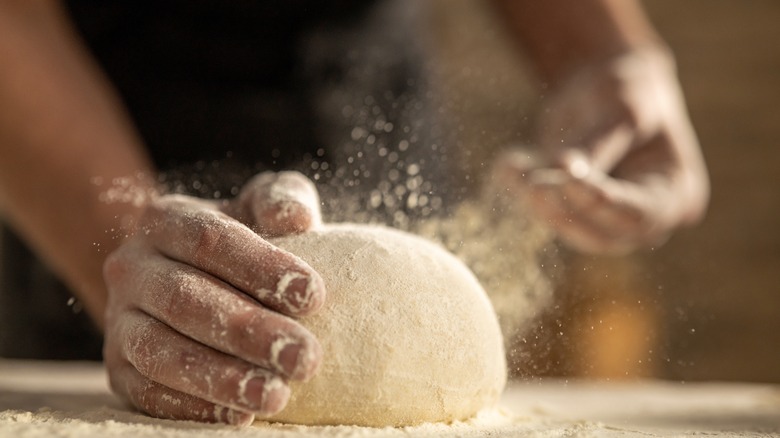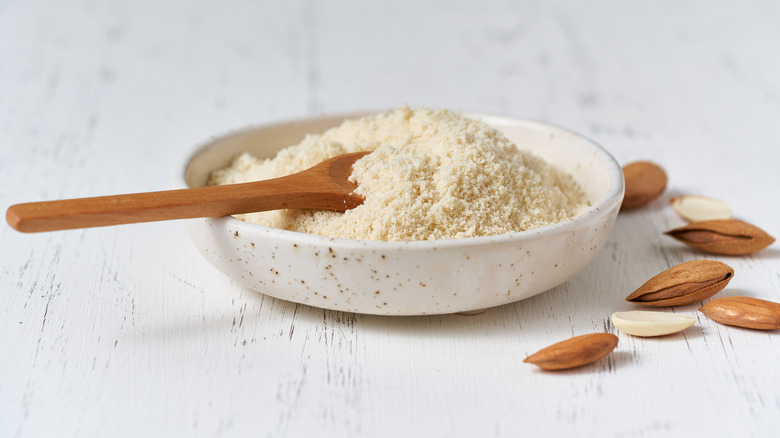What Makes Gluten-Free Flour Spoil So Much Quicker Than Wheat Flour?
If you enjoy home-baked sweets, you probably always have some baking staples on hand. Pretty much all homemade goodies call for some variety of sugar and flour, so avid bakers might even find it advantageous to buy these ingredients in bulk. Unlike wet baking ingredients, like cream or eggs, these dry goods can often keep on the shelf for a long period of time. However, while they may have a longer shelf life than milk, that doesn't mean they won't ever go bad. Flour does not stay fresh indefinitely, and it turns out the type of flour you purchase plays a pretty big role in just how long you'll want to keep it before it goes bad.
While whole wheat flour packs more nutrients per serving, it spoils at a slightly higher rate than white flour, thanks to the additional oils that the bran and germ contain. Your basic, refined, all-purpose white flour stays good for up to eight months, depending on how it's stored. White flour is made when the wheat undergoes a process to remove the bran and germ, leaving just the endosperm behind. While this process does remove some healthy nutrients, like fiber and protein, it also makes white flour less prone to spoiling and enables it to have a longer shelf life.
Gluten-free flours are high in fat
Flour now comes in many forms and the days of simply using one big package of all-purpose white flour for everything seem to have passed. With more and more people changing their eating habits, along with the rise in awareness of conditions such as gluten intolerance, many alternative types of flour are now on the market.
Gluten-free flours, such as those made from almond or coconut, are a great alternative for those who live gluten-free but don't want to completely give up their favorite baked goods. Luckily, these flours can easily be substituted in many delicious recipes for cookies, brownies, or any number of other tasty treats. However, home bakers should be aware that gluten-free flours spoil more quickly than standard wheat flour, so it might not be the best idea to buy it in bulk.
When it comes to spoilage, fat is a major culprit. Nuts tend to be high in fat, so nut flours contain more fat than white flour, which makes it likely to turn rancid more quickly. Additionally, nut flours tend to have a higher moisture content than wheat flour, making them more susceptible to mold. Therefore, high-fat gluten-free flours have a much shorter shelf life of just three to six months.
Flour should be stored in a cool, dry place
Regardless of which type of flour you buy, however, storing it properly is essential to extending its longevity. Flour, whether it is all-white, wheat, or even almond flour, should be kept in a cool, dry place, in a sealed, airtight container. Storing flour in the refrigerator can also help extend its shelf life for as long as one year, while flour that is sealed in the freezer can last for up to two years without a decline in quality.
Of course, the most important things to look out for when trying to tell if your flour has gone bad are its appearance, taste, and smell. While use-by or expiration dates can be a useful guide for determining flour's freshness, ultimately it all comes down to how the ingredient will taste. If it still looks fine and has no odor, then it's probably fine to use, even if the expiration date has passed. On the other hand, any flour that has a visible appearance of mold or discoloration, smells sour or rancid, or tastes a little off, should be tossed immediately.


